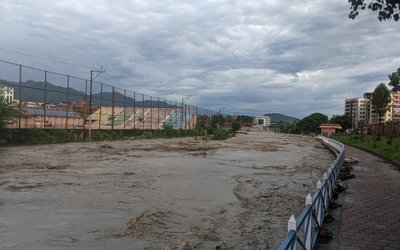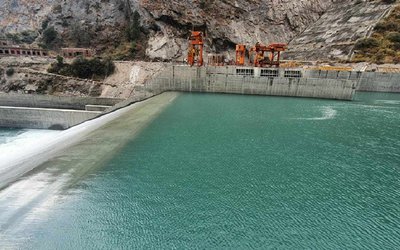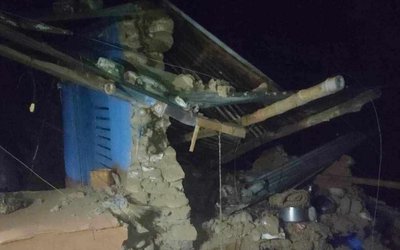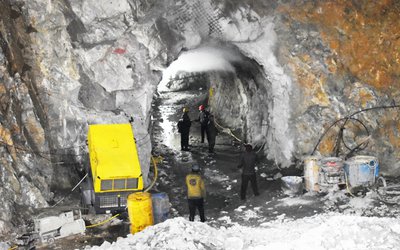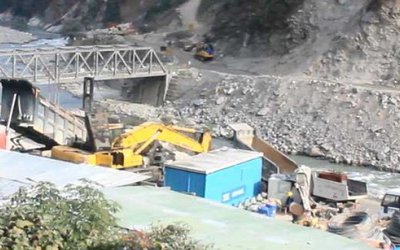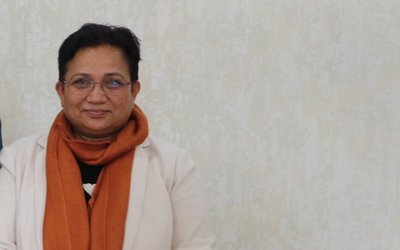
Minister of Science and Technology and Education Giriraj Mani Pokharel and Norbert Barthle, Member of the German Parliament and Parliamentary State Secretary to the Federal Minister for Economic Cooperation and Development jointly inaugurated the modern Load Dispatch Center in Kathmandu.
Based on Supervisory control and data acquisition (SCADA), which is an industrial control system which is used in many modern industries like energy, manufacturing, power, water transportation, the center is equipped with latest technologies
Inaugurating the center, Norbert Barthle, Member of the German Parliament and Parliamentary State Secretary to the Federal Minister for Economic Cooperation and Development said, “We are standing here at a very important place. The modernized load dispatch center that we are opening today is the heart of Nepal's power system. I should really say it is the brain of the system. The entire grid is controlled from this center! “
He said that the German government already supported the load dispatch center when it was first built in 2004. But control technologies have developed much further since then. That is why, in 2014, we committed 7 million Euros for the modernization of the center's hardware and software. During the big earthquake in 2015, transmission and distribution systems and the center itself were damaged.
“After all, this center is very important for Nepal's people and its economy. So I would like to express my deep respect for the hard work of the center's staff. Thanks to your work, power supply was restored just a few hours after the 2015 earthquake. The experience of the earthquake has shown very clearly that high-tech systems are very sensitive. So in regions that are prone to natural disasters, a backup system at a second site is absolutely vital.
"You are working for that by building the backup system for this center about 100 kilometers west of Kathmandu at Hetauda. Through this project, we are contributing to stable and sustainable power supplies and to Nepal's ambitious climate targets. First, the load dispatch center makes power synchronization possible, which is becoming more and more important. Second, such power synchronization is a technical precondition for selling power among countries in South Asia. Third, only about two-thirds of the population currently has access to power."
"Remote rural areas continue to be underserved. People there use traditional energy – that is, wood – for their cooking. Everybody knows that this has many negative impacts, such as respiratory [res-pirr-e-tori] diseases and erosion. Fourth, Nepal's rapidly growing population needs more and more energy so more power must be produced. At the same time, the transmission infrastructure must be expanded and, in many places, modernized, because technical and other losses amount to up to 20 percent of power production. Fifth, power generation from hydropower drops to just one-third of capacity during the dry season. During those times, production is at 400 megawatts, whereas peak demand is about 1,500 megawatts. The retreat of glaciers will probably worsen the problem. At the moment, this deficit can only be compensated through the expensive import of coal power from India. But the synchronized grid system that is facilitated by this center will provide a basis for buying a more sustainable energy mix, and for Nepal to export some of its power.
“I greatly welcome the fact that Nepal is part of the Nationally Determined Contribution (NDC) Partnership that Germany helped to launch. Through the Partnership, we support 3 developing countries and emerging economies in their climate activities in the fields of budget, economic and energy policy. Nepal is currently updating the NDCs that it adopted for 2016. I am confident that your new goals will include an increase in the share of renewable energy in the energy mix. Nepal's energy targets are very ambitious.”

“The government is making massive investments from public funding in the expansion of power generation and in better infrastructure. But in view of the great challenges, the donor community, too, should do its part. Germany and Nepal have a long tradition of working together in the energy sector. During the 1980s and 1990s, we made big financial contributions to the large Lower and Middle Marsyangdi power stations. Now the focus of our cooperation has shifted from large-scale investments to renewable energy and energy efficiency as well as transmission infrastructure. Here, too, the goal of the German government is to contribute to poverty reduction, economic growth, and climate change mitigation. We, therefore, support, among other things, decentralized renewable energy, so that even people in remote regions – like those I met today in Dhading – will get access to power. Germany's involvement in the multi-donor Energising Development (EnDev) program, which provides loans for small hydro-power stations and grid expansion, serves the same goal. So I am pleased that we were able to commit another 6 million Euros in grant funding in 2019 for solar power, using funds from the German Climate Technology Initiative. This comes in addition to the 9 million Euros which we committed at the 2018 government negotiations for solar drinking water pumps and irrigation pumps and grid-connected solar power plants. In order to make all investments – both public and private – effective and sustainable, we need first, political reforms in the energy sector. And this is also true for Germany, which is in the middle of its energy transition. We know that there are many challenges in this policy field. And we know that it is very important to overcome the obstacles to reform. And second, we need economic and legal incentives for investments and savings. Both private households and the private sector have to become active.
He also thanked Minister and Kul Man Ghising for the good and close cooperation with the BMZ and with KfW and GIZ that they have enjoyed over many decades. We will continue to be your partner. “
SCADA systems organize multiple technologies that allow processing, gather and monitor data at the same time to send instructions to those points that transmit data.
With the use of Programmable Logic Controllers (PLC) hardware and powerful bus communication links along with SCADA software and hardware’s in power generating stations, delivering an optimal solution for each and every process operation is flexible with advanced control structures. SCADA structure in power generation supervises several operations, including protection, controlling and monitoring. The functions of SCADA in power generation include continuous monitoring of Speed and Frequency.
Geographical monitoring of coal delivery and water treatment processes,
Supervising the status of circuit breakers, protective relays, and other safety-related operations, Generation operations planning, Active and reactive power control
Turbine protection and Load scheduling and Historical data processing of all generation related parameters.
SCADA for Power Distribution System
The power distribution system deals with the transmission of electric power from generating station to the loads with the use of transmission and distribution substations. Most of the power distribution or utility companies rely on manual labor to perform the distribution tasks like interrupting the power to loads, all the parameter hourly checking, fault diagnosis, etc. The implementing SCADA to the power distribution not only reduces the manual labor operation and its cost but facilitates automatic smooth operations with minimizing disruptions.
Under the structure of SCADA in the power system, it collects the entire data from various electrical substations (even at remote locations) and correspondingly processes the data. Programmable logic controllers in substations continuously monitor the substation components and corresponding transmits that to a centralized PC based SCADA system. In the event of any outages of power this SCADA allows to detect of the exact location of fault therefore without waiting for the calls from customers, SCADA gives an alarm system to the operators for identifying and preventing it. And also in substations SCADA automatically controls isolator switches and circuit breakers for violating parameter limits, thereby continuous inspection of parameters is performed without a line worker. Some of the functions of SCADA in the power distribution system are given below.
LDC Has Been A Key For Our Management: MD Ghising
Kul Man Ghising Managing Director of Nepal Electricity Authority said that this system is a modern one and help to managing the power system very efficiently. “This system will also ensure efficiency and quality of energy,” said Ghising. “Now on the supply of electricity including the demand and supply can manage with high efficiency from the center.
Excerpts of the statement of MD Kul Man Ghising:
Today I am feeling proud and happy for timely and successfully completing the up-gradation of the Load Dispatch Centre (LDC) which has been a key for our management while making a move from Load shedding to No-Load shedding era in Nepali energy sector history. Therefore, I would like to thank my NEA team for all their effort in making this project a success. Special thanks go to the supplier, SEIMENS, and the consultant, Tractable, for their respective roles in this project.
Germany, the long-standing partner of Nepal, had financed the establishment of a full-fledged LDC earlier in 2003. And, now again, we have received the German financial assistance for strengthening, expanding and upgrading of the facilities from the earlier time. Moreover, today, the gracious presence of his Excellency the parliamentary state secretary from the Federal Ministry for Economic Cooperation and Development, BMZ Germany for the inauguration of this upgraded facility has reflected the German Government's high priority for the promotion of energy sector in Nepal.
I am very much thankful to our Minister, Giri Rajmani Pokharel for his gracious presence in this joint inauguration and I believe that his presence with us today has already reflected the value that the GoN has given to the energy sector and for the support that the country has been receiving from Germany.
Like in Germany and other developed countries, the Government of Nepal has also considered energy as one of the keys to unlocking the development of this country. The white paper of the GoN in May 2018 has an ambitious target of generating 3,000 MW in 3 years; 5,000 MW in 5 years and 15,000 MW in 10 years. The government of Nepal has foreseen to achieve this target with an intervention from the government and also from private sectors. Besides Generation, challenges in front of NEA are expansion and up-gradation of Transmission and Distribution infrastructures for domestic supply and Cross broader Trade of electricity.
Analyzing NEA’s capacity as a whole, the major challenge that I have seen is the need for huge investment for larger infrastructures in all the Generation, Transmission and the distribution sectors for reliable, quality and safe supply.
Looking at the scenario of the last three decades, Nepal has always been struggling to meet its domestic electricity demand. Even now the generation capacity of the domestic hydropower projects is not sufficient to meet the domestic demand in the dry season. Rather, we are relying on Indian import for managing our demand and supply for deficit times of the year. Coming to a brighter side of the story, now we have started talking about cross-border electricity trading for the export of electricity. Currently, Nepal has a total installed capacity of above 1,219 MW from both NEA and IPP owned Generation projects. However, we will be adding 1000 MW in the current fiscal year only. Hence, Nepal clearly sees an excess generation of power in the wet season within 1-2 years when the majority of the under-construction projects will be completed.
Together with the cross-border trading, Nepal is also seriously considering the ways for increasing the domestic demand. NEA for this purpose is putting much of its effort into the extension, expansion, and upgrading of the facilities for transmission and distribution systems.
I would like to take this opportunity today to thank again to the government of Germany and German people for their support towards Nepal and special thanks to the German Development Cooperation for timely and rightly identifying the need of this country and supporting the transmission line and distribution sectors. The Support of German government for lower and Middle Marsyangdi Hydro Electric projects in the earlier times were the right support at right times and similarly, the on-going support for Chilime-Trishuli and Lekhnath Damauli transmission lines together with the support for distribution network strengthening in few districts have been again the right support at right times. I would like to thank the support of the EU received through KFW for the distribution system projects in the transmission line corridor. I would also like to thank the Norwegian Government for their continued support to Nepal in the power sector.
On demand-side management, NEA is stepping for the actions for loss reduction, energy efficiency and working to promote other possible demand increasing actions like fuel switch and e-mobility to reduce the fossil fuel currently being imported. I believe the cooperation of Nepal and Germany in the future will also continue in the direction of our need and I am confident that NEA will always be trusted as a reliable partner for Germany to execute the energy projects in Nepal.
- Weather Forecast: Partly To Generally Cloudy With Rain And Thunder Acrosss Nepal
- Apr 19, 2025
- Minister Dahal Directed To Complete The Dannune Portion Of Road Before Monsoon
- Apr 18, 2025
- Kanchenjunga Diamond Festival Being Celebrated From Today To Mark The 70th Anniversary Of The First Successful Ascent
- Apr 18, 2025
- RPP To Hold Protest In Restricted Areas Of Kathmandu On April 20
- Apr 18, 2025
- Weather Forecast: Partly Cloudy With Rain And Thunder In Kathmandu, Pokhara, Biratnagar And Janakpur
- Apr 18, 2025
